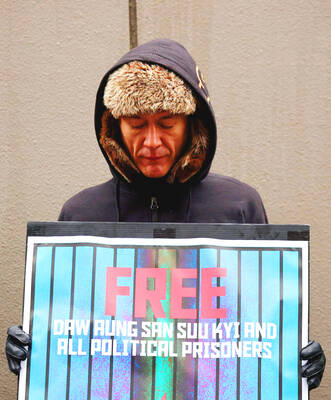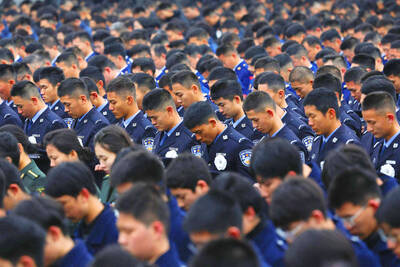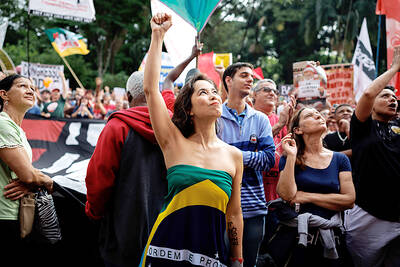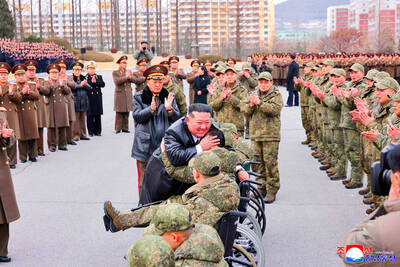Regional mediator and South African President Thabo Mbeki arrived in Zimbabwe yesterday for talks on the country’s disputed elections ahead of a possible run-off that has raised concerns of further violence.
The South African leader, whose “soft diplomacy” approach toward the crisis in Zimbabwe has triggered criticism at home and abroad, was scheduled to meet Zimbabwean President Robert Mugabe. It was not clear if he would discuss the post-election turmoil with the opposition Movement for Democratic Change (MDC) as well.
MDC leader Morgan Tsvangirai is currently out of the country. The MDC said it had not received any invitation from Mbeki to meet its leadership during his one-day visit to the Zimbabwean capital.
“We know he [Mbeki] is meeting President Robert Mugabe. But we have no official communication that he is going to meet with the MDC or its leadership,” said George Sibotshiwe, a spokesman for Tsvangirai.
Tsvangirai says he won the presidential poll outright and his party says it is not planning to participate in a run-off. Tsvangirai has yet to give a final answer on whether he will contest.
If he does not, the 84-year-old Mugabe will automatically win. Mugabe has ruled since independence in 1980.
Regional heavyweight South Africa is heading efforts by the regional SADC grouping to defuse the tension in Zimbabwe, which suffers from 80 percent unemployment, chronic food and fuel shortages and the world’s highest inflation of 165,000 percent.
The last time Mbeki met with Mugabe after the election, he denied there was a crisis, a comment which was widely attacked by political rivals and the international community.
Western countries have called on African states to do more to end the standoff. A flood of refugees and concerns about instability and violence have taken their toll on the region.
UN Secretary-General Ban Ki-moon has been talking to African states about how the world body could help make a run-off credible and has expressed concern about the violence.
But Mbeki has said Zimbabwe’s problems should find an African solution instead.
Asked in an interview on al-Jazeera television this week whether it would be helpful if UN monitors were allowed into Zimbabwe as election observers to help calm the situation and instil trust in the process, Mbeki said: “I don’t like the idea that suggests that as Africans we cannot do the job.
The MDC, rights groups and Western nations have accused the ruling ZANU-PF party of launching a campaign of violence to ensure Mugabe wins a run-off. ZANU-PF denies the charge, has appealed for calm, and accuses the MDC of carrying out attacks.
The opposition and civic groups have also said soldiers beat civilians and armed militia groups.
The Zimbabwe National Army told the state-run Herald newspaper it was not behind the violence and was trying hard to ensure peace returns.
Army spokesman Alois Makotore “categorically distanced the army and any of its members from allegedly harassing, assaulting people and robberies,” the paper reported yesterday.
He said the army was concerned by a rising number of incidents in which soldiers were facing provocations, abuse and attacks by some members of the public “for no good reason.”
Mugabe’s government has repeatedly called for an end to the violence, in which the opposition says more than 20 people have been killed, thousands displaced and agricultural groups say 40,000 workers have been expelled from farms.
It has rejected criticism of the elections and the weeks of delays in confirming winners, saying it was running a free, fair and democratic election process.

The Burmese junta has said that detained former leader Aung San Suu Kyi is “in good health,” a day after her son said he has received little information about the 80-year-old’s condition and fears she could die without him knowing. In an interview in Tokyo earlier this week, Kim Aris said he had not heard from his mother in years and believes she is being held incommunicado in the capital, Naypyidaw. Aung San Suu Kyi, a Nobel Peace Prize laureate, was detained after a 2021 military coup that ousted her elected civilian government and sparked a civil war. She is serving a

China yesterday held a low-key memorial ceremony for the 1937 Nanjing Massacre, with Chinese President Xi Jinping (習近平) not attending, despite a diplomatic crisis between Beijing and Tokyo over Taiwan. Beijing has raged at Tokyo since Japanese Prime Minister Sanae Takaichi last month said that a hypothetical Chinese attack on Taiwan could trigger a military response from Japan. China and Japan have long sparred over their painful history. China consistently reminds its people of the 1937 Nanjing Massacre, in which it says Japanese troops killed 300,000 people in what was then its capital. A post-World War II Allied tribunal put the death toll

‘NO AMNESTY’: Tens of thousands of people joined the rally against a bill that would slash the former president’s prison term; President Lula has said he would veto the bill Tens of thousands of Brazilians on Sunday demonstrated against a bill that advanced in Congress this week that would reduce the time former president Jair Bolsonaro spends behind bars following his sentence of more than 27 years for attempting a coup. Protests took place in the capital, Brasilia, and in other major cities across the nation, including Sao Paulo, Florianopolis, Salvador and Recife. On Copacabana’s boardwalk in Rio de Janeiro, crowds composed of left-wing voters chanted “No amnesty” and “Out with Hugo Motta,” a reference to the speaker of the lower house, which approved the bill on Wednesday last week. It is

FALLEN: The nine soldiers who were killed while carrying out combat and engineering tasks in Russia were given the title of Hero of the Democratic People’s Republic of Korea North Korean leader Kim Jong-un attended a welcoming ceremony for an army engineering unit that had returned home after carrying out duties in Russia, North Korean state media KCNA reported on Saturday. In a speech carried by KCNA, Kim praised officers and soldiers of the 528th Regiment of Engineers of the Korean People’s Army (KPA) for “heroic” conduct and “mass heroism” in fulfilling orders issued by the ruling Workers’ Party of Korea during a 120-day overseas deployment. Video footage released by North Korea showed uniformed soldiers disembarking from an aircraft, Kim hugging a soldier seated in a wheelchair, and soldiers and officials